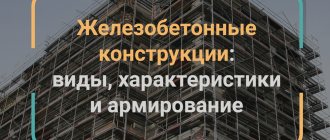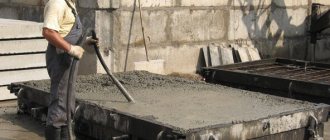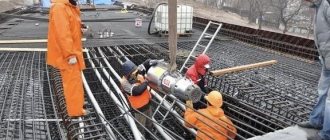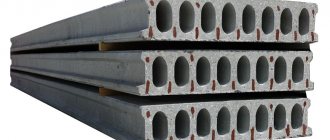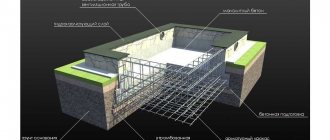Classification and methods for identifying defects
According to generally accepted ideas, in most cases defects arise at the manufacturing stage of reinforced concrete structures and products.
It should be noted that there is no legalized classification of defects in reinforced concrete structures and products. Nevertheless, defects in reinforced concrete structures and products can be divided into superficial and internal. Surface defects are shrinkage cracks, foreign inclusions, broken ribs, unevenness, lack of a protective layer, voids and cavities, humidification and moisture filtration (in winter), efflorescence, oil and rust stains.
Internal defects are voids formed on the reinforcement frame due to the freezing of the concrete mixture during its rapid thickening and dense reinforcement of the structure, under-compacted (non-vibrated) areas, power cracks, incorrect placement of concreting seams and lack of contact between the layers of concrete in the concreting seams. Sinkholes are formed on the surface due to air entrapment due to the thick consistency of the lubricant and its uneven application. Under-compacted areas are formed due to insufficient plasticity of the concrete mixture and its rapid setting. Exposed reinforcement occurs due to improper installation of formwork. Shrinkage cracks are formed due to improper heat and humidity treatment of concrete. The lack of surface contact in the concreting joint is due to long breaks during the laying of the mixture. Incorrect placement of concreting seams relative to the axes of the structure is a consequence of a violation of concreting technology.
Inspections of monolithic reinforced concrete structures carried out by our organization have shown that about 30% of them are under-compacted sections of concrete, about 20% are cracks of various types and 30% are defects in concreting joints. It should be noted that the requirements for prefabricated reinforced concrete products and monolithic structures in terms of surface quality differ quite greatly (see table below)
| Indicators | Products (GOST 13015-2012) | Structures (SP 70.13330.2012) |
| Concrete surface category | from A1 (glossy) to A7 (hidden surfaces) | from A3 (for improved painting) to A7 (hidden surfaces) |
| Grease and rust stains | not allowed | allowed for category A7 |
| Shell diameter, mm | 0-20 | 4-20 |
| Height of local influx, mm | 0-5 | 10-20 |
| Depth of socket on edge, mm | 2-20 | 5-20 |
| Cracks, opening no more than, mm | 0,1 — 0,2 | 0,1 — 0,4 |
| Exposure of reinforcement | not allowed | |
| Under-compacted areas | not regulated | not allowed |
| Contact strength of concrete surfaces in a concreting joint | not regulated | must be ensured |
| Location of concreting working seam | not regulated | The surface of the seam must be perpendicular to the vertical axis of the structure |
When identifying defects, our organization strictly adheres to the requirements of SP 63.13330.2012 “Concrete and reinforced concrete structures” and SP 70.13330.2012 “Load-bearing and enclosing structures” [1-2]. At the same time, we divide the identified defects according to the degree of danger into minor, significant and critical. In our opinion, this allows us to draw more reliable conclusions about the compliance of the surveyed structures made of monolithic reinforced concrete with the requirements of design and regulatory documentation. Of the variety of defects, we record and evaluate the following defects:
- cracks of all types;
- exposure of reinforcement;
- voids and shells;
- foreign inclusions;
- defects in concreting seams, including their incorrect location;
- under-compacted areas.
For instrumental description of defects, we use instruments and equipment that meet the requirements of GOST 26433.1-89 “System for ensuring the accuracy of geometric parameters in construction. Rules for performing measurements. Factory-made elements." To measure the opening width of cracks, a microscope with a division value of 0.02 mm is used. To measure the depth of cracks, a Pulsar 2.2 device is used. To measure the sizes of shells, a ruler (diameter) and calipers (depth) are used. To measure the sizes of under-compacted areas, foreign inclusions and exposed reinforcement, a tape measure or ruler. A square is used to measure the depth of the edges.
When cracks are detected, the width of their opening is measured. If exposed reinforcement, shells and voids, under-compacted areas and foreign inclusions are detected, their dimensions are determined. For concreting seams, their position relative to the axes of the structure and the absence of contact of concrete surfaces in the seam are recorded. Recently, when instrumentally measuring defects, we additionally use ultrasonic devices, which allow us to obtain a more objective picture. Measuring the depth of a crack, for example, makes it possible to classify it as structural, affecting the load-bearing capacity of the structure, or as non-structural (shrinkage). The ultrasonic method also makes it possible to determine the presence or absence of contact between concrete layers in the working joint of concreting and the boundaries of under-compacted areas of concrete. In addition, to identify internal defects (cavities of various types, incorrect placement of fittings, etc.), we began to use the MIRA ultrasonic tomograph.
Displacement of reinforcement frame in reinforced concrete
Those reinforced concrete structures that have irreparable defects should under no circumstances be used in construction - this significantly affects safety. Among the most common defects that cannot be eliminated is displacement of the reinforcement frame. This happens due to a shortage of steel elements in production. As a result, we get uneven placement of reinforcing loops. Such a defect significantly affects the rigidity of the structure and significantly reduces the service life. This defect also includes the use of too thin a protective layer on the reinforcement. Because of this, the steel parts of the structure are subject to destruction from corrosion, reducing the strength of the product. As a rule, this is the result of improper storage of structures.
Causes of defects in structures and products
Modern technology for the construction of monolithic structures involves the use of concrete mixtures with a cone draft of 16–24 centimeters. Such mixtures contain a lot of entrained air, which, upon contact with the formwork, remains on it and, after the concrete hardens and the formwork is removed, leaves shells of various sizes on the surface of the concrete. The adhesion of air bubbles is greatly facilitated by a thick lubricant on the surface of the formwork.
Concrete mixtures with a cone draft of 16–24 centimeters are very prone to delamination and water separation and for this reason lead to uneven density distribution and low durability of monolithic structures.
The technology for manufacturing reinforced concrete products has some differences from the technology for constructing structures. At the same time, reinforced concrete products are traditionally subject to higher requirements for surface quality (see table). There are several reasons for the deterioration of the surface quality of reinforced concrete products, the main of which can be considered uneven application of lubricant to the surface of the mold, insufficiently effective compaction of the concrete mixture and its incorrect formulation. The main difference in the technology for manufacturing reinforced concrete products is the use of much less plastic concrete mixtures - instead of a mixture with a cone draft of 20-24 cm, a mixture with a cone draft of 4...8 cm is used. Such mixtures contain much less entrained air and, when molded horizontally, make it possible to obtain surfaces of a fairly high category , up to A1. However, with the cassette production method (vertical molding), with any consistency of the lubricant, air is pinched on the surface of the mold and the inevitable formation of cavities occurs. In addition, with intense vibration, characteristic of the technology for manufacturing reinforced concrete products, additional air entrainment occurs in the concrete mixture, which also leads to the formation of cavities.
Gravel coating
This surface consists of the bulging of crushed stone elements in the overall concrete mass. Such a defect significantly affects the quality and convenience of finishing work. Usually the cause of this defect is the formwork - a gravel coating appears when it is used several times without timely repair. To eliminate all irregularities from crushed stone, the structure must be thoroughly cleaned with steel brushes. Next, the product is washed with water under high pressure, after which a plaster composition is applied to ensure greater smoothness.
Proposals for improving control methods
Work to identify defects in our organization has been established and is being carried out as planned. However, in our opinion, it is necessary to continue to improve both methods and control tools. After analyzing the existing and used methods for identifying and measuring defects, I would like to propose the following:
1. Continue to clarify the list of defects that are subject to detection during the inspection of products and structures and link them in more detail to the classifier of the hazard of defects. In particular, it would be possible to introduce an additional gradation of defects based on maintainability, namely, introduce such categories of defects as removable or irreparable.
2. When instrumentally determining the opening width of cracks, replace the Brinell microscope, which is inconvenient in construction conditions, with a set of needle-type probes, ensuring measurement accuracy with its help at the level of 0.02 mm (like a microscope).
3. Legalize the determination of the depth of cracks, since this makes it possible to classify detected cracks as shrinkage cracks (shallow - up to 5% of the thickness of the structure) or force cracks - with a depth of more than 5% of the thickness of the structure.
4. If there are sinkholes, assess the surface quality of reinforced concrete products and structures only according to categories (A1...A7). Also worthy of consideration is the method for assessing surface quality, which is based on differential porosity indicators (average pore size and coefficient of variation of their sizes) with its reference to GOST 13015 [5].
5. When laying concrete mixtures in monolithic reinforced concrete structures, it is imperative to control the spreading of the cone and water separation of the concrete mixtures
Suggestions for reducing defects
The problem of improving the quality and reducing the defectiveness of monolithic reinforced concrete structures can be solved in different ways. According to the author, in terms of accessibility and cost, these methods can be arranged in the following order:
- Applying lubricant to the formwork only by mechanized means.
- Use of aggregates with a maximum particle size of no more than 10 mm.
- The use of cements containing more than 20% mineral additives. The most effective in this regard may be the use of Portland slag cement (contains up to 80% ground blast furnace slag).
- Restoring the consistency of concrete mixtures before laying them in structures is carried out exclusively with the help of additional introduction of a plasticizer.
- Order a concrete mixture 1 grade higher than required. In this case, by increasing the cement content, part of it will act as a microfiller and will reduce water separation and delamination of concrete mixtures, which in turn will reduce the defectiveness of hardened concrete (cavities, under-compacted areas, etc.)
- When preparing concrete mixtures, it is mandatory to introduce a finely ground component (mineral additive). Information - in many countries, the introduction of finely ground components into concrete mixtures is fixed at the legislative level.
Bottom line
In order to choose the right quality reinforced concrete product, it is recommended to involve employees of construction companies and accredited laboratories in the purchasing process. These specialists will be able to immediately identify all damage, both obvious and subtle. Also, do not forget that to order a large number of reinforced concrete structures, you should give preference to trusted manufacturing companies. Ask for reviews about the quality of their products. We do not hide information about us; reviews of our services can be read in the “Reviews” section.
Innovative technology for preparing concrete mixtures
All over the world it is believed that high-quality concrete mixtures should contain a total of 500...600 kg (per cubic meter) of fine components in the form of cement and inert microfiller. However, in Russia, finely dispersed components in a concrete mixture amount to 300... 400 kg and are represented only by cement. This causes the appearance of defects both on the surface and inside monolithic reinforced concrete structures. A generally accepted solution to the problem of improving the quality of monolithic reinforced concrete structures is the use of self-compacting concrete mixtures. However, due to the complexity of preparation and the high cost of such mixtures, they are used only in 2-5% of cases. An alternative to SCC can be a two-stage technology for the preparation of concrete mixtures developed by the author [6]. The first stage of this technology involves mixing cement, a mineral additive and a plasticizer, the second involves mixing a complex binder obtained at the first stage, as well as water, sand and crushed stone using traditional technology using existing BSU equipment. As practice has shown, in concrete mixtures prepared using the proposed technology there is practically no water separation and separation, although they have a very plastic consistency (cone spread is more than 500 mm), and the quality of monolithic reinforced concrete structures is very high. In the proposed technology, at the first stage, both a mixer for the production of dry mixtures and a ball mill can be used. In the case of using a ball mill, the grade of cement increases and, accordingly, it becomes possible to reduce its consumption. Two-stage technology is especially advantageous in the production of modern concrete mixtures containing a large number of components (cement, microfiller, plasticizer, hardening retarder or accelerator, antifreeze additive, stabilizer for underwater concreting, etc.).
Chips on reinforced concrete
Most of the defects described above are of the fatal type. As an exception, we indicated microcracks that are removed during the process of pouring concrete. The product can then be used for its intended purpose. In addition, even those reinforced concrete structures that are chipped can be used in construction. At the same time, their reliability and strength are not lost, since defects are eliminated directly in production. Often removable defects appear as a result of loads or mechanical influences. A great example of this is stair steps.
What can I cover with to prevent them from cracking?
Minor defects can be corrected yourself if they are related to the plaster. If the appearance is associated with deformation of the main structure, then you need to seek help from specialists.
Exterior materials for cracks
- Neomid Professional ─ universal putty. For deep cracks and potholes. Contains reinforcing fibers.
- SEMIN Fibrelastic ─ elastic putty for external and internal work. Especially for “breathing” cracks and joints.
- Profix ─ mounting and putty mixture. This is a flexible putty with easy application.
Crack mixtures for interior work
- SEMIN Rebouchage ─ filling putty for interior work.
- UNIS High-thickness ─ gypsum putty. Universal, easy to apply, crack-resistant. Warranty up to 15 years.
- TERRACO Handyflex ─ super elastic crack filler.
DIY repair
Puttying cracks in a monolithic house
To “cure” defects in monolithic walls, you will need the appropriate tools and materials:
- sealing composition (sealant, foam) and concrete mortar;
- putty knife;
- sanding mesh and holder for it;
- brush with stiff bristles;
- jointing tool.
What is the best way to cover up cracks in a load-bearing block wall?
Smooth cracks appear on the masonry when it is not reinforced. There are several putty options for wall repair. Let's look at some ways to eliminate the defect.
- widen the crack;
- prime;
- seal with mortar.
For small cracks, it is permissible to use tile adhesive, mounting foam or special foam for blocks.
If there is a straight crack in the corners, how to fix it correctly
Repairing cracks in brickwork: how to remove them
- Repairing cracks in brickwork begins with removing dirt, dust, chipped bricks, fallen mortar and other unnecessary elements.
- It is good to wet the crack with a spray bottle, since the base of the brick tends to absorb water. By throwing the solution, it will penetrate deeper into the crack.
- Cover the wide part of the defect with mortar, and fill the narrow part with sealant from a “gun”.
- Since the sealant is white and the solution is gray, the crack needs to be given an aesthetic appearance. To do this, apply tile adhesive with a spatula. It tolerates temperature changes well, is frost-resistant, and moisture-resistant.
- After the building material has dried, sand the seam and smooth out any unevenness.
Repairing cracks in a concrete wall of a panel house with cement mortar
- First, check the condition of the crack, widen it with a hammer and chisel.
- Use a compressor to blow off all the dirt.
- Depending on the brand of cement, prepare a solution. To do this, mix sand, cement, water, beat until mushy.
- Lubricate the defect with PVA glue for better adhesion of the crack to the solution.
- Fill the hole with mortar to the level of the wall.
- Smooth out the seam.
- After drying, clean up.
If there are cracks in a new house, how to repair them
- Use a special tool to widen the crack.
- Clean it from dust.
- Prime to improve the adhesion of the putty.
- Seal the seam with putty using a putty knife.
- To prevent recurrence of formations, glue with sickle tape.
- Hold the top of the tape with one spatula, and smooth the tape with the second.
- Reapply putty and allow time to dry.
- After 24 hours, sand the surface of the seam.
Rules of care
A set of measures aimed at achieving the grade strength of concrete and ensuring integrity consists of performing the following tasks:
- ensuring minimal shrinkage of the poured composition;
- preventing accelerated drying of the mixture;
- neutralization of temperature changes;
- prevention of mechanical stress and the influence of chemical reagents.
Compliance with these requirements will ensure an increased service life of concrete, which will have high strength.
When pouring concrete, remember to follow these recommendations:
When mixing the mixture, you need to follow the recipe and strictly observe the proportions between its components.
What to follow when repairing cracks: main rules
In order for the load-bearing capacity and enclosing properties of walls to be preserved for a long time, you need to be guided by the “General Recommendations for Crack Repair Technology.”
Repair of cracks is carried out after drawing up a map of defects and a defect list, which confirm the results of the examination and the reasons for their occurrence.
When choosing a technology for repairing unpleasant formations, you need to consider:
- wall material;
- number of flaws;
- defect width;
- branching of flaws;
Only then carry out repair work:
- embroider;
- clean from dust;
- Rinse;
- fill with suitable plaster.
Bad service
The structure must be maintained after a certain period from the date of completion of construction.
Some structures may need to start dealing with wear and tear issues very early on, while others may perform very well for many years depending on the quality of the design and construction.
In addition, regular exterior painting of the building helps to protect the building from moisture to some extent.
Waterproofing and protective coatings on reinforcing steel or concrete are all second line of defense, and the success of their protection will largely depend on the quality of the concrete.
It is necessary to eliminate the grooves as soon as possible before corrosion of the steel inside the concrete begins and spalling of the concrete occurs.
Finally, it is important not only to repair damaged concrete, but also to prevent moisture and harsh chemicals from entering the concrete, so
Any copying of texts or fragments of text, pictures without the consent of the author is prohibited by copyright.
If you liked the article, please don’t skimp on your likes

